Using Modes in Improvisation
The following are some thoughts on using the modes in improvisation as well
as more general comments regarding improvisation.
Section.1
The basic chord structure in jazz
Although the triad is considered the basic chord structure for the purpose of
studying harmony, the style of jazz typically uses 7th chords, i.e. Major 7th,
Dominant 7th, Minor 7th, etc. as the most common chord structure.
Seventh chords seem more common than triads in jazz,
and it is also common to see even more complex chords such as 9th, 11th and 13th
chords in jazz. More on the 7th chords can be found in this
additional lecture on 7th chords.
Section.2
Using Modes with common chord progressions
Major keys
The II-V-I chord progressions and the subsets of II-V and V-I are the
foundation of functional harmony. Many musicians think in terms of the
modes of the major scale that is related to each chord of the II-V-I
progression. As an example consider the II-V-I progression in the key
of C: the II chord is Dm (or Dm7) the V chord is G (or G7) and the I is C
(or Cma7). The C major scale is the source for all of the notes of the
progression and a musician could improvise over that chord progression
thinking the single scale of C major. Many musicians like to think in
more detail by using modes of the major scale in direct relationship to
the roots of the chords. So for the II chord the musician might think
D dorian instead of C major. It's a subtle difference of course, as both
contain the same notes. But when thinking in D dorian the chord tones
of the prevailing harmony are 1, 3, 5, 7 etc of the current mode. When
the harmony of the V chord, G7, is played the musician could improvise
thinking in G mixolydian, again the same notes as C major. However when
thinking in G mixolydian the chord tones of the the G7 are 1, 3, 5, 7 of
the mode. Actually it's somewhat intuitive to think in this manner, one
doesn't even need to know the names of the modes to use this technique.
It's the same as thinking "on the Dm7 chord play the C scale but the
Dm7 chord tones start on the second note of the C major scale. On the
G7 scale, keep playing the C scale but the G7 chord tones start on the
the fifth note of the scale, and on the C chord keep playing in C."
Knowing where the chord tones are of the prevailing harmony is important
to an improvising musician as they may want to play a melody that outlines
the harmony. Thinking "D dorian to G mixolydian to C major" during a II-V-I in
the key of C is really just a different way of looking at the major scale
during a common harmonic context. It only looks complex in print, but it's
really quite simple and many find it a useful technique even if they don't
actually think of the modal names but instead are thinking of using the
C major scale but emphasizing different portions of the scale according
to which chord is being played. In this context one might think of D dorian
as the portion of the C major scale that best represents the Dm7 chord and
likewise G mixolydian as the portion of C major that best represents the G7 chord
giving more of a musical hologram regarding the role of C major within the chord
progression. This is not to suggest that one should use this as a guide to
the range or starting note of a improvised melody but instead the "modal
thinking" can simply help the improviser keep track of the chord tones of the
harmony by relating it to the scale that starts on the root of the current chord.
On the other hand, some prefer to ignore these modal viewpoints as
they find them an exercise in over-analysis.
If you do use these techniques, the subsets II-V and V-I can be treated similarly
when in the major keys. The common chord resolution of V-I is used countless times
in the harmony of songs. As an improvising musician the most basic scale to play is
the major scale of the I chord (George Russell argues that Lydian is the true scale
for the I chord in Major). In the key of C the V-I is G7-Cma7 and the C major
scale works over both chords. Using the modal thinking technique, a musician
might think "G mixolydian to C major" for scale choices, knowing that
they both contain the same notes but G mixolydian will contain the chord
tones at the 1, 3, 5, and 7 positions of the mode.
Even though one might be thinking in terms of modes, the II-V-I harmony
that is described in this section is not referred to as 'modal'. However,
there are tunes that are considered inherently 'modal' discussed
in the next section.
Section.3
Minor Keys
The minor keys have more variety in scales and present an interesting study
in chord/mode relationship. Before continuing, let me state that the term
mode and scale are sometimes used interchangably and although the dorian mode
is usually explained as originating from the major scale, the dorian mode is
not considered dependent on the major scale for it's existence. Often the
term dorian scale is used instead of dorian mode. Any scale can be used
to create a set of modes. For instances if we start with the harmonic
minor scale, we can create a whole new set of modes using harmonic minor
as a "parent" scale (instead of major being the parent scale as is the case
in the common modal system). Instead of creating additional names for
all of the these modes, a new scale can be described as the "C harmonic
minor-5th mode", meaning it's the same notes as C harmonic minor but
starting on the fifth note. Modes of both the harmonic minor and melodic
minor scales are used in jazz improvisation, increasing the number
of available scales considerably.
Meanwhile, back to the regular modes, many jazz tunes in minor keys
use the dorian mode as the scale for the I chord. Also there is a style
of jazz known as 'modal jazz' which use the modes as the parent scale for
a tonality. For instance the Miles Davis tune "So What" (from the album Kind of Blue)
uses simple harmony that can be written on a chart as having two sections, A and B,
in the following form.
A A B A
| 8 bars of Dm7 | 8 bars of Dm7 | 8 bars of Ebm7 | 8 bars of Dm7 |
The improviser will play several choruses of the AABA form during a solo.
In reality, many more chords than the literal Dm7 structure are used
but this is a result of improvisation not predesigned harmonic changes.
A voicing used by pianist Bill Evans in the original Miles Davis
recording of "So What", was a stacking of P4ths from D, to G to C,
to F with a ma3rd on top to A. This voicing was not literally a Dm7 chord
but it became a hip substitution for Dm7 that can be analyzed as Dm7sus4.
In fact, Evans approaches the chord from a whole step above, all the
notes of both chord structures come from the D dorian scale.
The series of P4th also make it a candidate to be termed "quartal" harmony
(chords built in 4ths) as opposed to the usual tertial harmony (chord built
in 3rds). Below is the opening phrase of the main section of 'So What' and
also an example of the typical voicings of quartal harmony applied to the D dorian
scale.
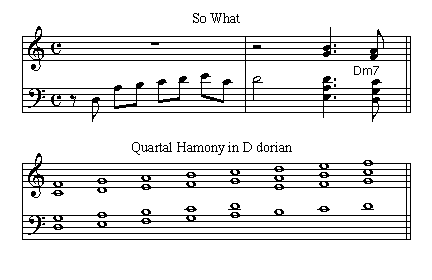
For each 8 bar section of 'So What' the dorian scale is used. The Dm7 chord of
the A section calls for D dorian and the Ebm7 of the B sections uses Eb dorian.
The Dm7 isn't a II chord in C it is the tonic chord (I) in the key of D,
D dorian. Many of the modal tunes of the 60's used modes from the major
scale but like "So What" they weren't in the keys of the major scales but
instead in the key of the mode's starting note. Tunes such as Maiden
Voyage, Impressions, Little Sunflower, and Dolphin Dance make use of the
Dorian, Phrygian, Lydian and/or Mixolydian scales in a manner that uses
those scales as the parent scale of a tone center. Tunes suchs as this which
do not use the traditional major or minor scales and instead use one of
more of the modes as the parent scale are referred to as 'modal' tunes.
Even within non-modal tunes in jazz (i.e. jazz standards) it is common for the
minor II-V-I chord progression to use dorian on the I chord. This is in contrast
to classical music which might use aeolian (natural minor) as the scale used on
the I chord in minor. In contrast to the how the major scale works over
all of chords of the II-V-I in major, the dorian scale does NOT work over
all of the chords of the minor II-V-I progression . During the II chord in
minor the chord quality is usually m7b5 (sometimes called half diminished).
In the key of Cm the II chord is usually Dm7b5. The mode that works well
with that chord is D locrian (same notes as C natural minor). The V chord
presents many possibilities for scale choices. One of the common choices
for the V chord is C harmonic minor, 5th mode, i.e. C harmonic minor but start
on G (the 5th note). Additional scale choices are mentioned in the section
on Common Alterations and Substitutions.
Using the modal technique of matching the root of the chord to a starting tone
of a mode, one way of navigating through the changes of the II-V-I in minor
is to think "on Dm7b5 play D locrian, on G7 play C harmonic minor-5th mode
and on Cm7 play C dorian" Unlike the II-V-I in major which in it simplist
form boils down to a single set of notes (the major scale), in this case
there isn't a single set of notes that satisfies all of the chords.
Here we play D locrian (same as C natural minor), C harmonic minor then
C dorian. The three scales contain one or two differences between them
but they contain mostly common tones. Once again, the technique of selecting
a scale for each chord isn't meant to make the musical situation overly
complex but instead to give the player a very specific linear view of the harmonic
progression. In this case we are in C minor and each of the chord/scale choices
(Dm7b5/D locrian, G7/C harmonic minor-5th mode, Cm7/C dorian) provide a good set of
notes for each specific chord.
Section.4
Instant Composing
The process of improvisation is very individual and each must find their own path but
since improvisation is sometimes described as composing music in the moment, it is
worth thinking of common compositional devices one could use "on the fly".
Improvising in the the style associated with jazz standards is more based on
the harmony of the songs than the original melody. However it is useful to examine
some common manipulations of melodic material that can be used.
melodic variations
- inversion - invert the intervals of the melody
- retrograde - play the melody backwards
- retrograde inversion - upside down and backwards
- augmentation - stretch out the rhythms, i.e. turn quarternotes into half notes etc.
- diminution - compress the rhythms
-
Melodic inversion
The original melody can be used as a source to create new melodies. One technique involves
inverting the melodic direction of the original melody. There are two different ways to
use melodic inversion.
method one
One way involves changing the direction of the melodic interval of
each note and use the same interval, i.e. if an interval from the original melody is an
ascending 3rd then the inverted melody would be a descending 3rd. The quality of the
3rd (major, minor) could be adjusted so that you are in the same scale, i.e. if the original
melody used an ascending major 3rd, the inverted melody might use a descending minor 3rd
if the descending major 3rd resulted in a note outside the scale.
method two
Another way of using melodic inversion is to move to a interval that is the octave
compliment of the original interval, i.e if the original melody moves from from C up
to E (up a major 3rd), then the interval inversion would be from C down to E (down a minor 6th).
In this manner, the inverted melody will contain the same notes as the the original but the
melodic contour will be very different. However, this type of inversion doesn't work well
for melodies containing as series of 2nds such as scale passages. The series of 2nds when
inverted by this method turn into a very angular series of 7ths.
merging the two methods
The problem with method one is that sometimes the leap of a 3rd or larger when inverted
will result in a note that just doesn't work. As mentioned above sometimes a simple
adjustment from minor to major (or dim, or aug) in the quality of the of the interval will
solve the 'wrong note' problem. Another solution might be to use method two when it results
in a better sound. Also one can use the idea of inversion as a loose guide and simply change
direction compared to the original, i.e. when the original melody moves up, the inverted melody
move down, and vice versa, you choose the interval size for the inverted melody without strict
adherence to the size of the interval from the original melody.
Melodic retrograde
The retrograde of a melody is that melody played backwards. This technique is one
of the common manipulation used with a tone row in 12 tone serial music. With a
melody the results may or may not be of use to the improviser. But it is worth a
quick experiment, perhaps a passage played backwards might be surprisingly expressive.
Melodic retrograde inversion
This process takes the original melody a plays it backwards and inverted.
A strict mathematical processing of the original melody might not be useful
material in many situations but a using this concept as a general guide for
creating new material might prove fruitful.
Rhythmic Augmentation
This process takes a rhythmic passage from the original and stretches it out.
One example would be to double the duration of all of the notes. Other ratios
in time manipulation might be explored.
Rhythmic Diminution
This process takes a rhythmic passage from the original and compress it.
One example would be play a rhythmic passage twice as fast. Other ratios
in time manipulation might be explored.
All of these explorations of the original melody are the 'perspiration' that
hopefully will lead to 'inspiration' during an improvisation.
These melodic and rhythmic devices can be drawn from in the moment of creation
and add cohesion to a improvisation if the improviser has previously explored the
variations of the original melody in these ways during practice sessions.
It is common for improvising jazz musicians to practice a piece over and over.
But unlike a classical musician who is reading a score with precisely the notes required,
the jazz musician strives to play it differently each time.
Section.5
Basic Training
The following is what I consider to be some of the basic training required
to improvise in the style typical of jazz standards.
- II-V-I patterns
- knowing the harmonic landmarks (chord tones)
- common alterations and substitutions
- b9 and #9
- b5 and #5
- tritone substitution
Many jazz musicians will practice melodic ideas using common chord progressions as
a harmonic framework within which to paint their melodic improvisation. This
practice session might consist of dozens of choruses being played so that many
ideas can be explored. Commonly not a single note is written down and all improvisations
and patterns are spontaneously sent directly from the mind to the instrument.
I consider this process "preparing for the improvisation". No extended passages
are memorized but you gain a good feel for the scales and harmonies of the
piece on which you will improvise.
-
II-V-I patterns
-
Below are two patterns I find useful. Both are melodic outlines of the
II-V-I chord progression. The melodic essense of these pattern comes from
a passage from Thelonius Monk's "'Round Midnight". In that phrase the harmony
is II-V, and Monk's melody ascends root, 3rd, 5th, 7th of the II chord and resolves
down a scale degree to the 3rd of the V chord. In this expanded melodic pattern here
the phrase is extended to arpeggiate both the V and I chords as well. In the routine
that I use, I start in the key signature of no sharps or flats (C/Am) first playing in
C using Dm7-G7-Cma7 then move to the relative minor (Am) using Bm7b5-E7-Am#7
then move to the key signature of 1 flat, do the same routine and continue all around the
circle of fifths. This type of playing is considered 'inside' the chord changes.
pattern 1
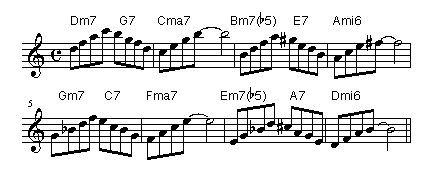
pattern 2
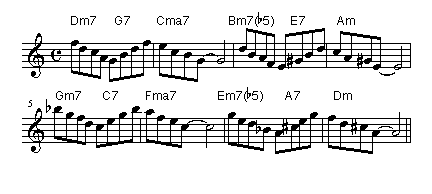
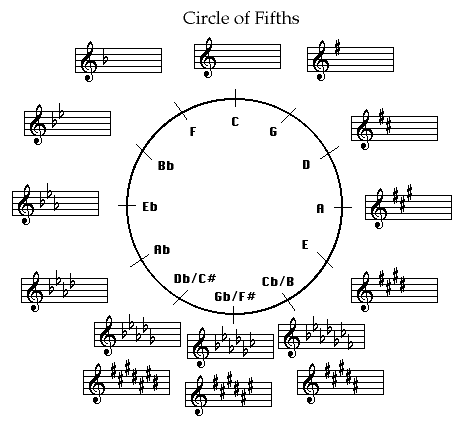
I find the playing of these pattern helpful to my understanding of guitar fretboard.
In an opposing viewpoint, others argue that practicing patterns is antithetical
to true improvisation.
-
knowing the landmarks
-
When one is confident about finding the chords tones of the harmony in a II-V-I it
is easier to improvise in the context of music that commonly uses that chord progression,
i.e. jazz "standards". The above patterns will allow you to become familiar with the
landmark notes of the moving chord progression. One exercise that is used by jazz musician
is 'running the changes', that is to play a series of eighth notes or faster throughout the
tune's changing chord progression, often outlining the chord structure in manner similar to
the shown exercise.
It is during these practice sessions that an improviser will learn
the sound of the different chord tones of the harmony of the song.
-
Common Alterations and Substitutions
-
If one uses the basic scale choices discussed above several interesting notes choices
are NOT available. Jazz musicians have long been attracted to certain altered tones
especially when the V chord is being sounded. It is common to hear jazz musicians
altering the 5th or 9th of the V chord. On the V chord in C (G7) the 5th is
D and the 9th is A. The altered 5ths are Db (b5) and D# (#5) while the altered
9ths are Ab (b9) and A# (#9). Sometimes these tones are the result of a chromatic
scale segment being used, i.e. playing the note D on the Dm7, the note D# on the G7
(using a #5) followed by the note E on the Cma7 chord. Another example of chromaticism
is using the note A on the Dm7, the note Ab on the G7 (using a b9) followed by the
note G on the Cma7 chord.
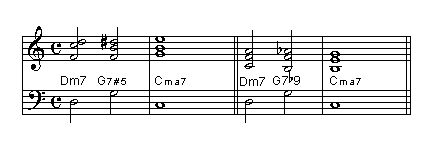
In addition to the C harmonic minor-5th mode mentioned above as a scale choice
for the V chord, C melodic minor-5th mode is another choice. Another is the
seemingly odd (but very effective) choice of Ab melodic minor-7th mode (sometimes
called G superlocrian). This scale contains the root, 3rd, and 7th of the G7
chord plus that altered 5ths (b5 and #5) and 9ths (b9 and #9). When starting
on G this scale is spelled G, Ab, Bb (A#), Cb (B), Db (C#), Eb (D#), F, G. Still another
choice is the half/whole diminished scale starting on G: G, Ab, Bb, B, C#, D, E, F, G,
which contains both altered 9ths (Ab, Bb/A#) and the enharmonic of the the b5 (C#/Db).
The use of altered tones provide an introduction to a concept sometimes known as
playing "outside". This concept of playing outside can be taken to extreme where
the scale choice purposely conflicts with the prevailing chord. In these examples
the "outside" quality is more mild, providing some tension that is resolved in
the change to the I chord.
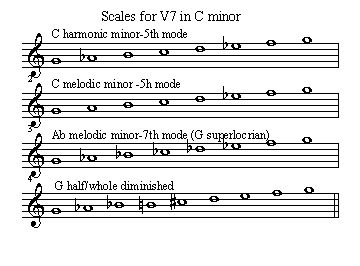
The V7 chord with the 5th lowered is an interesting chord structure. The chord
G7b5 is spelled G, B, Db, F. As it turns out, that is the enharmonic spelling of
another chord of the same structure whose root is a tritone away from G (say what?)
Yes, a G7b5 contains the same notes (enharmonically) as Db7b5 which is spelled
Db, F, Abb (G), and Cb (B).

Since these two chords are enharmonically equivalent, the notion of
substituting a Db7 type chord for a G7 type chord has been expanded to include
several chords from the Db7 family to be used as substitutes for the G7 in the
II-V-I chord progression. When the Db7 is substituted for G7 the progression
becomes Dm7-Db7-Cma7 which is analyzed as II-bII-I. This technique is known
as "tritone substitution". This chord substitution technique is, of course,
available to those who are playing the chords but it can also be used by
someone who is playing a single line improvisation.
Below are some examples of these ideas.
-
b9 and #9
-
[insert example of II-V-I pattern using b9, #9]
-
b5 and #5
-
[insert example of II-V-I pattern using b5, #5]
-
tritone substitution
-
[insert example of II-V-I pattern with tritone substitution]
Section.6
Is this really improvising?
Indeed, I am suggesting that the improvising musician doesn't simply create a
ad lib solo without first preparing for the musical situations that will
be encountered during the solo section, i.e. the chord changes and the
implied scale choices. The improvising musician needs to have technical
command of several scales and know sound of those scales in their mind's ear.
Even a collection of certified "hip" licks might
be at the tip of one's fingers. So, is this really improvising?
It's true that if you prepare for the improvisation with the techniques
described here that you would be 'qualified' to play in a uncreative pattern
oriented manner that is lacking in musical spirit, we've all heard that
sound.
But there isn't any reason that being prepared should result in a lack
of creativity. I find that being prepared for the situation is liberating,
I can go outside on a limb if I want because I'm confident I can find my
way back inside the chord changes if I get in trouble. And if I want
to play inside, I'm confident that I won't accidentally play any clams.
I remember attending a music education conference several years ago where
the pianist Mike Garson was performing/lecturing. He told a story of
when he lived outside of London and rode the train into the city. A
classical viola player rode the same train and they would talk. The
violist was curious about improvisation and asked Garson how long would
it take the violist to learn to improvise well, as this wasn't something
that he was used to doing on his instrument. Garson, who measures practice
time in 100 hour blocks (i.e. "it will probably take x hundred hours to do this,
x hundred to do that") outlined a practice routine for the violist and after a
week or so the violist confessed that he wasn't really willing to put in that
kind of effort.
There is no magic pill.
Return to top of page
© Mike Sult